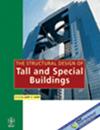Monitor wind characteristics and wind‐induced responses of a skyscraper during two typhoons
IF 1.3
3区 工程技术
Q3 CONSTRUCTION & BUILDING TECHNOLOGY
引用次数: 3
Abstract
Skyscrapers are wind‐sensitive structures due to their large slenderness ratio and good flexibility. Understanding the wind characteristics and wind‐induced response from the actual data provides first‐hand information for wind resistance design. This paper reports the wind properties and dynamic performance of a 632 m high‐rise building in Shanghai during the passage of typhoons Jongdari and Rumbbia. Field measurements obtained from the structural health monitoring system include acceleration and wind speed. The data analysis of turbulence intensity, turbulence integral length, and gust factor are compared and discussed. For the identification of dynamic characteristics, the stochastic subspace method and enhanced frequency domain decomposition method are employed to identify the modal parameters. Besides, the comfort assessment using peak value and root mean square of accelerations is compared with different standards. Studying the wind characteristics during the passage of typhoons and their impact on high‐rise buildings in a metropolis is expected to gain an insight into the dynamic mechanism of high‐rise buildings and collect a database for wind resistance design in typhoon‐prone regions.监测两次台风期间摩天大楼的风特性和风致响应
摩天大楼具有较大的长细比和良好的柔韧性,是风敏感结构。从实际数据中了解风特性和风致响应为风阻设计提供了第一手信息。本文报道了上海一座632 m高层建筑在台风“琼达里”和“伦比亚”通过期间的风性和动力性能。从结构健康监测系统获得的现场测量数据包括加速度和风速。对湍流强度、湍流积分长度和阵风因子的数据分析进行了比较和讨论。在动态特性辨识方面,采用随机子空间法和增强频域分解法辨识模态参数。并对不同标准下加速度峰值和加速度均方根的舒适性评价进行了比较。研究台风通过时的风特征及其对大都市高层建筑的影响,有望深入了解高层建筑的动力机制,并为台风易发地区的抗风设计收集数据库。
本文章由计算机程序翻译,如有差异,请以英文原文为准。
求助全文
约1分钟内获得全文
求助全文
来源期刊
CiteScore
5.30
自引率
4.20%
发文量
83
审稿时长
6-12 weeks
期刊介绍:
The Structural Design of Tall and Special Buildings provides structural engineers and contractors with a detailed written presentation of innovative structural engineering and construction practices for tall and special buildings. It also presents applied research on new materials or analysis methods that can directly benefit structural engineers involved in the design of tall and special buildings. The editor''s policy is to maintain a reasonable balance between papers from design engineers and from research workers so that the Journal will be useful to both groups. The problems in this field and their solutions are international in character and require a knowledge of several traditional disciplines and the Journal will reflect this.
The main subject of the Journal is the structural design and construction of tall and special buildings. The basic definition of a tall building, in the context of the Journal audience, is a structure that is equal to or greater than 50 meters (165 feet) in height, or 14 stories or greater. A special building is one with unique architectural or structural characteristics.
However, manuscripts dealing with chimneys, water towers, silos, cooling towers, and pools will generally not be considered for review. The journal will present papers on new innovative structural systems, materials and methods of analysis.

 求助内容:
求助内容: 应助结果提醒方式:
应助结果提醒方式:


